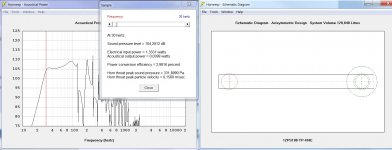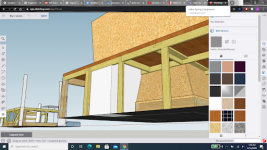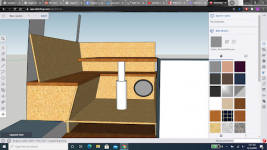I've spent some time looking around and have found plenty of threads with different ideals or constraints but I haven't been able to find one who's main constraint is power.
I'm about halfway through a bus conversion with my girlfriend for full time off grid living. Our living space will be solar powered by 400w of Renogy solar panels and 2 200ah batteries. The bus is insulated like a Yeti cooler and we will have insulated window coverings with foam padding to block out light and heat and bring down sound reflection from the windows when we want. The space is roughly 600cu ft total.
I want to build a 2.1 system primarily for when the bus is at rest, so it won't need to contend with road noise necessarily. It's my first build and I'm fairly confident I can figure out the full range aspect but I'm a little stumped on the subwoofer. I'm looking to cap the RMS of the system at around 80w, probably about half to the full range/midrange+ and half to the sub. Space is a tiny bit less of a constraint, we have plenty of empty space that I can jam a good sized enclosure into, perhaps a maximum of 3-4cu ft depending on the shape. It will be used for music and movies, and our tastes run the full spectrum. War movies to reality TV and classical to EDM and everything between. I've got a great sounding set of 60w M-audio speakers paired with a small 32w sharper image sub that sounds pretty bad but pretty loud in our much larger current kitchen. I can deal with a bit of boominess, I'm open to turning the sub off, heavily EQing, or listening to headphones when SQ becomes my primary concern while listening to, say, classical or jazz. I just want low end extension when watching movies, or listening to EDM or modern orchestral compositions like soundtrack Hans Zimmer or Thomas Bergersen.
What T/S specs should I focus on when looking at low power subwoofer applications? Which will sort depend on the answer to the following question which is what type of enclosure might work for this application?
I'm quite likely going to go for some form of vented design, perhaps a transmission line or a folded bass horn of some kind with a smaller (<8in) driver. I'd love to deep dive into this but there are so many projects I'm doing at the moment, so a bit of guidance might go a long way for me.
I'm about halfway through a bus conversion with my girlfriend for full time off grid living. Our living space will be solar powered by 400w of Renogy solar panels and 2 200ah batteries. The bus is insulated like a Yeti cooler and we will have insulated window coverings with foam padding to block out light and heat and bring down sound reflection from the windows when we want. The space is roughly 600cu ft total.
I want to build a 2.1 system primarily for when the bus is at rest, so it won't need to contend with road noise necessarily. It's my first build and I'm fairly confident I can figure out the full range aspect but I'm a little stumped on the subwoofer. I'm looking to cap the RMS of the system at around 80w, probably about half to the full range/midrange+ and half to the sub. Space is a tiny bit less of a constraint, we have plenty of empty space that I can jam a good sized enclosure into, perhaps a maximum of 3-4cu ft depending on the shape. It will be used for music and movies, and our tastes run the full spectrum. War movies to reality TV and classical to EDM and everything between. I've got a great sounding set of 60w M-audio speakers paired with a small 32w sharper image sub that sounds pretty bad but pretty loud in our much larger current kitchen. I can deal with a bit of boominess, I'm open to turning the sub off, heavily EQing, or listening to headphones when SQ becomes my primary concern while listening to, say, classical or jazz. I just want low end extension when watching movies, or listening to EDM or modern orchestral compositions like soundtrack Hans Zimmer or Thomas Bergersen.
What T/S specs should I focus on when looking at low power subwoofer applications? Which will sort depend on the answer to the following question which is what type of enclosure might work for this application?
I'm quite likely going to go for some form of vented design, perhaps a transmission line or a folded bass horn of some kind with a smaller (<8in) driver. I'd love to deep dive into this but there are so many projects I'm doing at the moment, so a bit of guidance might go a long way for me.
I would be surprised if the subs power demand would be an issue in terms of eating up your power reserves.
My biggest concern would be the idle dissipation of the amplifier used to drive it. Although technically speaking any power wasted as heat will simply reduce the amount of heating the bus needs.
As always you're playing with Hoffman's Iron law which balances box size, efficiency and bass extension.
With 3-4 cuft you're already doing well as this is a pretty big box. Next comes the question of bass extension. How deep do you want this to actually go? In a 3-4cuft box, with one driver you could end up with a ~85dB sensitivity figure and ~20Hz extension. With another driver ~40Hz extension with ~93dB sensitivity. Or something like that at least.
Power would only really be an issue if you intend on listening at very loud levels for extended periods of time but still I don't think this will be a problem.
For example. If you put
30W/4558T00 – Scan-Speak A/S
in a ported 4cuft box that's tuned to 20Hz you'll get a sub with what is essentially 20Hz extension and that's not even taking into consideration the cabin gain you're likely to get because of the bus small interior dimensions.
It only takes a 100 watt into 4 ohm amplifier to reach the limits of what that sub is capable of and even then you're getting 105dB at 20Hz. Probably 110dB in your bus.
With movies the bass from explosions tends to be sporadic and even the most highly compressed music has a 6dB crest factor leading to what would be a ~25 watt power usage continuously. This would deafen you way before the batteries ran out.
The only reason why car subs, and some hifi subs, tend to come with 1000+ watt amplifiers is because they are trying to use boxes that are tiny. Like really tiny. To compensate you need a massive amplifier. With 4 cuft you're not in that situation at all.
Now I only chose that 12" scanspeak as an example because I had the driver already loaded into my simulation software but lots will work in a similar fashion.
So you've got 3-4 cuft to work with how big of a driver can you actually use?
My biggest concern would be the idle dissipation of the amplifier used to drive it. Although technically speaking any power wasted as heat will simply reduce the amount of heating the bus needs.
As always you're playing with Hoffman's Iron law which balances box size, efficiency and bass extension.
With 3-4 cuft you're already doing well as this is a pretty big box. Next comes the question of bass extension. How deep do you want this to actually go? In a 3-4cuft box, with one driver you could end up with a ~85dB sensitivity figure and ~20Hz extension. With another driver ~40Hz extension with ~93dB sensitivity. Or something like that at least.
Power would only really be an issue if you intend on listening at very loud levels for extended periods of time but still I don't think this will be a problem.
For example. If you put
30W/4558T00 – Scan-Speak A/S
in a ported 4cuft box that's tuned to 20Hz you'll get a sub with what is essentially 20Hz extension and that's not even taking into consideration the cabin gain you're likely to get because of the bus small interior dimensions.
It only takes a 100 watt into 4 ohm amplifier to reach the limits of what that sub is capable of and even then you're getting 105dB at 20Hz. Probably 110dB in your bus.
With movies the bass from explosions tends to be sporadic and even the most highly compressed music has a 6dB crest factor leading to what would be a ~25 watt power usage continuously. This would deafen you way before the batteries ran out.
The only reason why car subs, and some hifi subs, tend to come with 1000+ watt amplifiers is because they are trying to use boxes that are tiny. Like really tiny. To compensate you need a massive amplifier. With 4 cuft you're not in that situation at all.
Now I only chose that 12" scanspeak as an example because I had the driver already loaded into my simulation software but lots will work in a similar fashion.
So you've got 3-4 cuft to work with how big of a driver can you actually use?
Typical listening at home uses less than one watt average power sent to the speakers. Most of the power is consumed by the electronics for simply being turned on.
A Test. How much Voltage (power) do your speakers need?
Idling power of the amplifiers is limited by:
A Test. How much Voltage (power) do your speakers need?
Idling power of the amplifiers is limited by:
- Using class D amplifiers
- Preferably of a recent design and designed for portable equipment, for example, something using the TPA3116D2 integrated circuit
- Sizing the amplifiers to reasonable amplifier power outputs and not higher
- If you can live with a power output of 12 W into 4 ohms: use an amplifier whose output stage directly runs on 12 V and does not use a voltage booster
Last edited:

With a B&C 12PS100 in a simple tapped pipe with a small coupling front chamber you get a solid 30 Hz response with a quite decent efficiency.
You don´t need more then a few watts to rattle your bus.
This kind of non-expanding tapped pipe does have a nice physical and tactile character for home theater and EDM usage.
I would use a high efficent driver with a class D amp (they are very power efficient) for this. The higher efficient the driver is, the less power you need to feed it to get where you want. A ported or TL cabinet is often the best to get low.
Pro audio drivers tend to be more efficient than hifi drivers and certainly for subs, they are as good when used right. Something like a BMS 12N630 in a 75L ported cabinet can easely be tuned to 30Hz and 25w does it already go above 102dB (without counting room gain that adds a few dB on plus) wich is very loud in a small closed space. Try to find a woofer that gets above 90dB efficient in the passband and that can get that low. And use dsp for this, passive crossovers eat power and power is sparse in a vehicle like a bus.
Pro audio drivers tend to be more efficient than hifi drivers and certainly for subs, they are as good when used right. Something like a BMS 12N630 in a 75L ported cabinet can easely be tuned to 30Hz and 25w does it already go above 102dB (without counting room gain that adds a few dB on plus) wich is very loud in a small closed space. Try to find a woofer that gets above 90dB efficient in the passband and that can get that low. And use dsp for this, passive crossovers eat power and power is sparse in a vehicle like a bus.
I would be surprised if the subs power demand would be an issue in terms of eating up your power reserves.
My biggest concern would be the idle dissipation of the amplifier used to drive it. Although technically speaking any power wasted as heat will simply reduce the amount of heating the bus needs.
Very good point haha!
As always you're playing with Hoffman's Iron law which balances box size, efficiency and bass extension.
Power would only really be an issue if you intend on listening at very loud levels for extended periods of time but still I don't think this will be a problem.
Possible on some days...
For example. If you put
30W/4558T00 – Scan-Speak A/S
in a ported 4cuft box that's tuned to 20Hz you'll get a sub with what is essentially 20Hz extension and that's not even taking into consideration the cabin gain you're likely to get because of the bus small interior dimensions.
It only takes a 100 watt into 4 ohm amplifier to reach the limits of what that sub is capable of and even then you're getting 105dB at 20Hz. Probably 110dB in your bus.
With movies the bass from explosions tends to be sporadic and even the most highly compressed music has a 6dB crest factor leading to what would be a ~25 watt power usage continuously. This would deafen you way before the batteries ran out.
That is very promising
The only reason why car subs, and some hifi subs, tend to come with 1000+ watt amplifiers is because they are trying to use boxes that are tiny. Like really tiny. To compensate you need a massive amplifier. With 4 cuft you're not in that situation at all.
So you've got 3-4 cuft to work with how big of a driver can you actually use?
As for the last, I'm still determining that. It's quite likely I could build it into the angled (16.9 degrees downward facing) toe kick/base area of our raised U-shaped bench in the rear. The space behind is ~2.6sqft in area and I might be able to go 18 inches of depth before my girlfriend kills me for taking up too much storage space, that's 3.9cu ft/110L - woofer displacement but already built like a sub enclosure and would only require internal bracing and maybe a double baffle, the bench is already going to be 3/4 birch ply. That is my ideal space for it, though it will require some convincing. Otherwise I have two promising locations of around 3.1cu ft/~87L, although this one could only be maybe 6-7in in height and a flat, rectangular shape, and 3.3 cu ft/~94L in a single seat bench base, each not accounting for material and woofer displacement that could each fit a 12in woofer.
Typical listening at home uses less than one watt average power sent to the speakers. Most of the power is consumed by the electronics for simply being turned on.
A Test. How much Voltage (power) do your speakers need?
Idling power of the amplifiers is limited by:
- Using class D amplifiers
- Preferably of a recent design and designed for portable equipment, for example, something using the TPA3116D2 integrated circuit
- Sizing the amplifiers to reasonable amplifier power outputs and not higher
- If you can live with a power output of 12 W into 4 ohms: use an amplifier whose output stage directly runs on 12 V and does not use a voltage booster
All very good information to know, thank you!
View attachment 875621
With a B&C 12PS100 in a simple tapped pipe with a small coupling front chamber you get a solid 30 Hz response with a quite decent efficiency.
You don´t need more then a few watts to rattle your bus.
This kind of non-expanding tapped pipe does have a nice physical and tactile character for home theater and EDM usage.
Also, very promising!
I would use a high efficent driver with a class D amp (they are very power efficient) for this. The higher efficient the driver is, the less power you need to feed it to get where you want. A ported or TL cabinet is often the best to get low.
Pro audio drivers tend to be more efficient than hifi drivers and certainly for subs, they are as good when used right. Something like a BMS 12N630 in a 75L ported cabinet can easely be tuned to 30Hz and 25w does it already go above 102dB (without counting room gain that adds a few dB on plus) wich is very loud in a small closed space. Try to find a woofer that gets above 90dB efficient in the passband and that can get that low. And use dsp for this, passive crossovers eat power and power is sparse in a vehicle like a bus.
Thank you, this is to the point and very usable advice. 75L would be an easier sell for the lady lol. HiFi drivers aren't something I've looked much into yet tbh. I will need to download some modeling software and start playing around with different options.
Thank you all for your sound advice, pun intended. I've got a lot to think on.
- Status
- This old topic is closed. If you want to reopen this topic, contact a moderator using the "Report Post" button.
- Home
- Loudspeakers
- Subwoofers
- Low power subwoofer for an off grid bus

